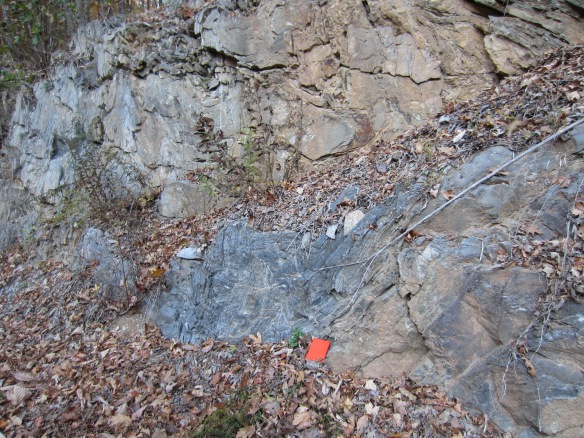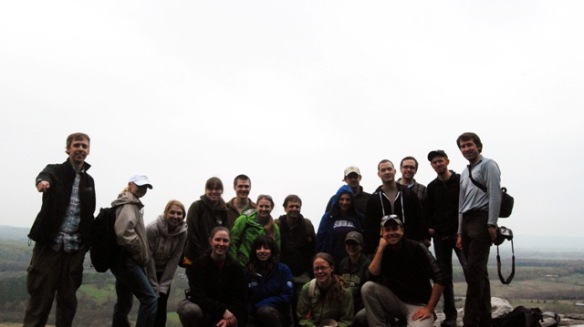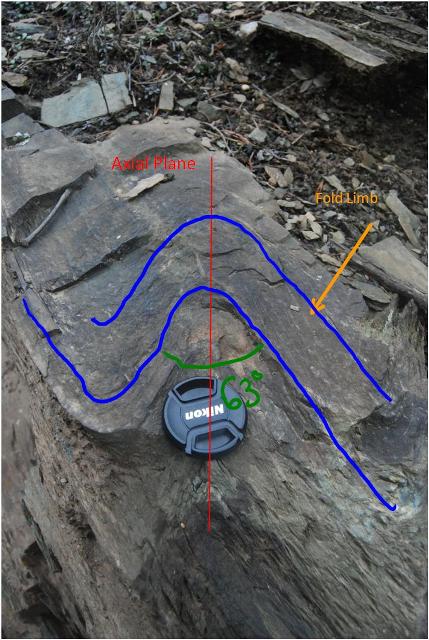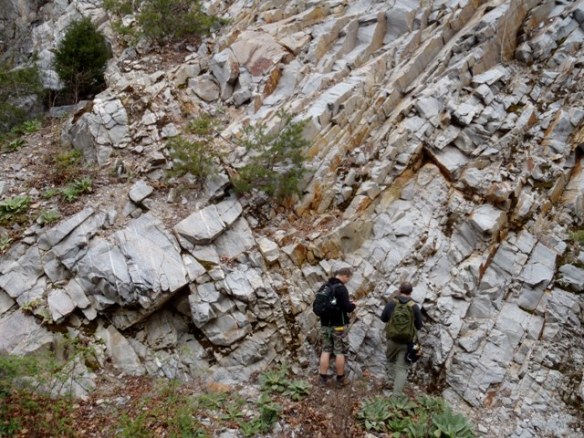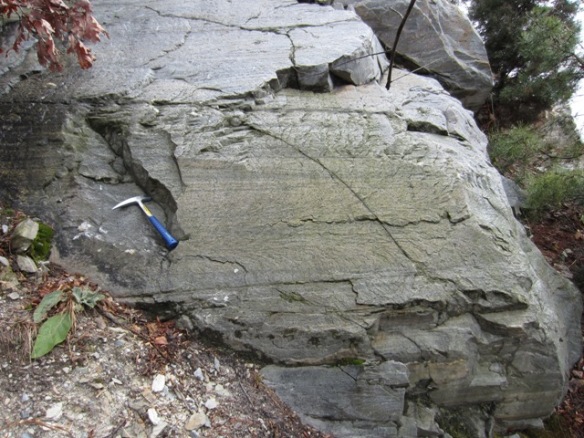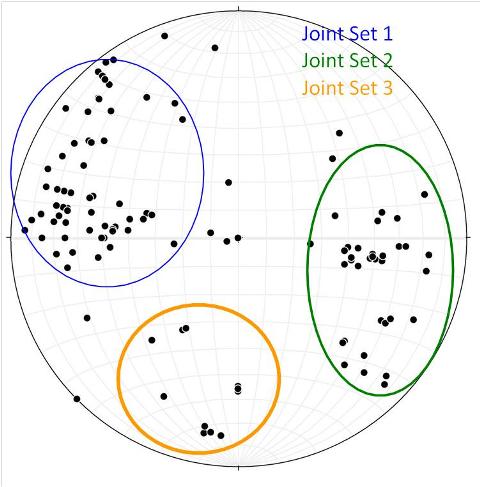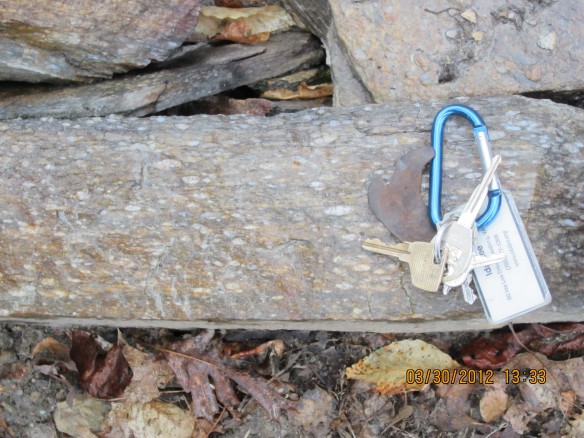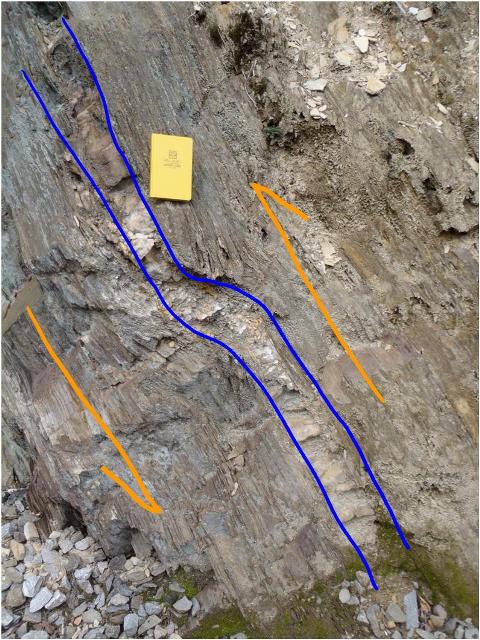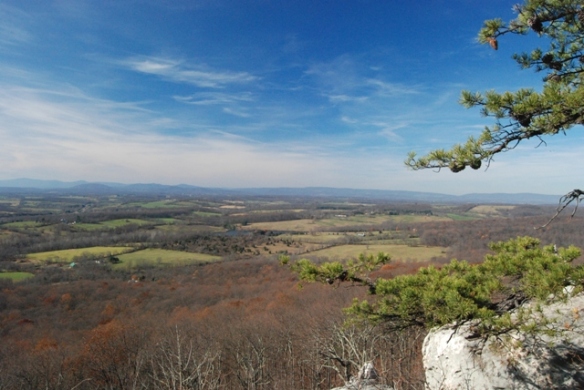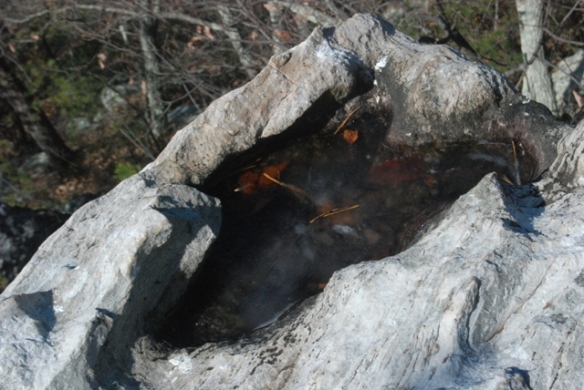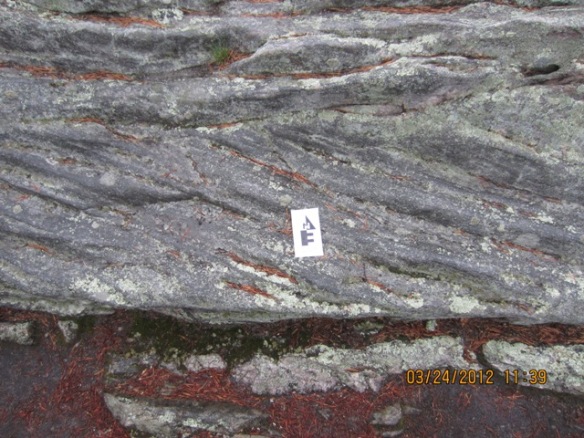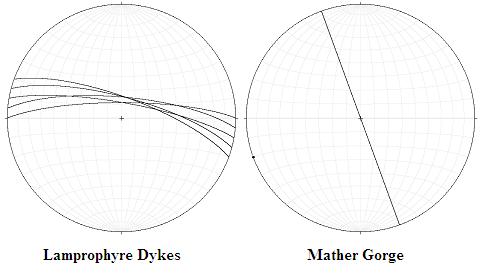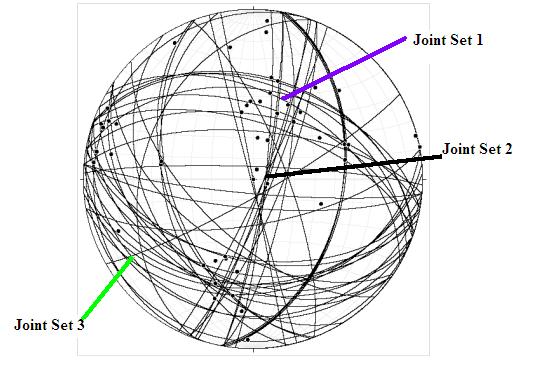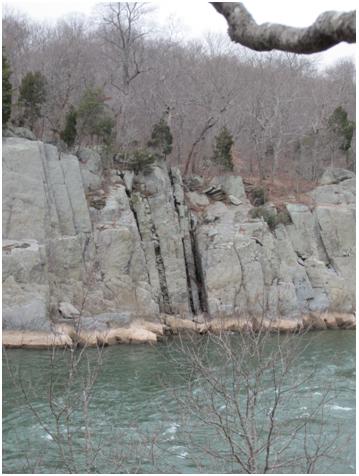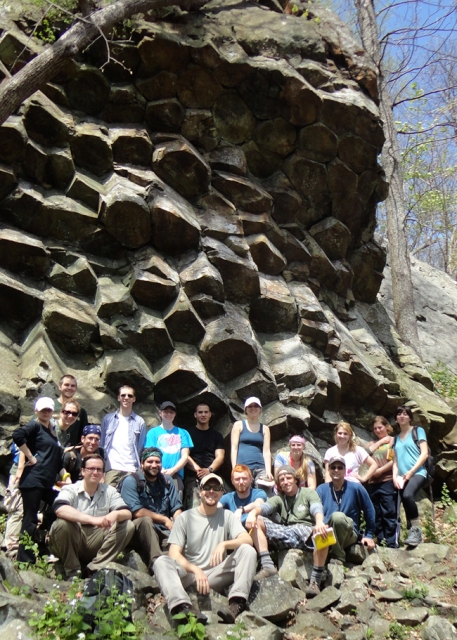
Photo coutesy of Callan B.
This past weekend my structural geology class took a weekend long trip out to the Blue Ridge and Valley and Ridge Geologic Providences of Virginia. Our intention was to spend the weekend working our way through the structural history of Virginia’s geology. Our first day and a half was spent in the Blue Ridge Anticlinorium. We then spent the remainder of Saturday in the Valley and Ridge Province within the Massanutten Synclinorium. Sadly, the weather was uncooperative and we were forced to call it quits Saturday night instead of camping at Massanutten and exploring the structures along the new Route 55 in West Virginia. In this post I will attempt to narrate the structural history of Virginia from 1100 Ma to roughly
First the Blue Ridge
*An important point to make is that when the Appalachian Orogeny is refered to I am referring to the three main orogenies that affected the east coast of North America culminating in the formation of Pangea. These orogenies include the Taconian, Acadian, and Alleghenian. The Taconian and Alleghenian were the primary forces in the Blue Ridge with the Alleghenian having the largest affect. This being said, it is difficult to tell which of the three imparted a specific deformational feature on the rocks we were seeing.
Working our way up…
Level 1: The Basement
The lowest portion of rock we encountered was the basement complex. The basement complex is comprised of a series of granitic and metamorphic rocks which formed some 1.1 billion years ago. This was during the Grenville Orogeny. The basement is very complex being made up of various types of igneous and metamorphic rocks. The region of the Blue Ridge where we were was mostly made up of granites and various grades of metamorphic rocks. As the orogeny progressed the oblique angle of collision between the continents caused shear zones to form in the basement. One such zone which we visited was the Garth Run High Strain Zone (GRHSZ). Within the shear zone we had the opportunity to see several deformational features. We saw various stages of mylonitic textures.

The image above shows the GRHSZ. The annotations in the image show that the amount of shearing increases across the outcrop from left to right. This is expressed by the amount of foliation which increases from least on the left to most on the right. This trend indicates that the center of the shear zone is off to the right in this image.
On a regional scale the shear zones fill the center of the Blue Ridge anticlinorium. The shear zones form an anastamosing pattern much like that of river with multiple oval shaped islands.
So, for showing off the zones, logically one starts with areas that display the least shear and working our way up. As shearing develops a rock first becomes micro-brecciated meaning it begins to break up into clasts similar to a small scale fault breccias. Once shearing continues we are into a the mylonitic structures. When the process stops with 10-50% of the rock is still crushed matrix while the remaining precentage porphyroclasts. If the process stops at this point we have what is called a protomylonite. There were no true protomylonites but there were some low grade mylonites. Unfortunately I failed to take any pictures.
If the process shown above continues even farther we get into the realm of mylonites where 50-90% of the rock is matrix with the rest being made up of porphyroclasts. An interesting thing to note is that once again the large regional scale structure is shown in the small scale structures. You will have to excuse the picture. The good mylonites were on the opposite side of a patch of poison ivy and seeing as it was the first day I did not want to tempt fate and try to pick my way through them.

Finally is the rock has been completely sheared out and smeared to bits we have a ultramylonite. In such cases 90% or more of the rocks is matrix with 10% or less of the rock being porphyroclasts. This is shown below. It almost looks like lamellar bedding in sedimentary rocks.
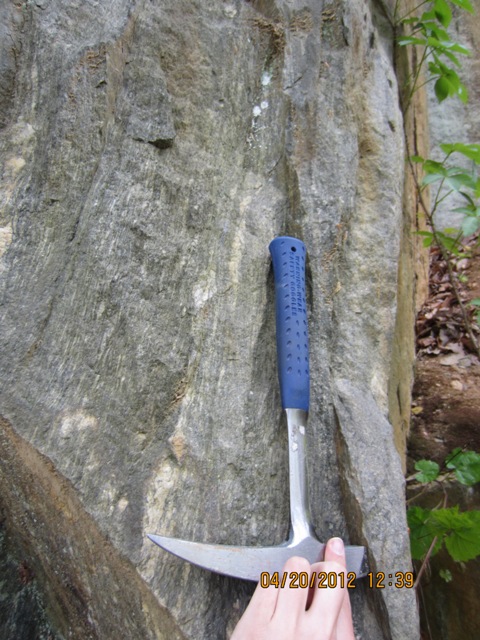
Another feature we found in the shear zone was a fold which was upright. Unfortunately it was outside our ability to safely reach in order to take measurements. Based on the Fleuty Fold Classification system I would call it steeply inclined and gently plunging. Under the Hudleston Classification system it would be an E4. The picture below shows the fold.

We also found some feldspar boudinage in the outcrop. This forms due to compressive forces where two directions of similar strength are stronger than the third causing the feldspar to become prolate. Eventually the feldspar breaks and the space is filled by the surrounding rock. It looks like sausage links which is how it got its name from the german word for sausage. This is shown below.

Augen are also visible in the outcrop. These are feldspars that have been sheared into an eye-like shape. In fact the work augen is the German word for eye. The process is similar to boudinage except on a smaller scale without the feldspar breaking.

Level 2: The Swift Run
Our next stop in our chronological elevator was the Swift Run Formation. In fact, we were lucky enough to visit the type locality for the formation. This is a feldspathic arenite sandstone which has some conglomeratic areas and mud lenses. The formation was deposited during the post-Grenville rifting. Since undergoing diagenesis the sediment has been lightly metamorphosed and now exhibits foliation which will be discussed later. At the time of deposition the formation contained various primary sedimentary features. The first one that I noticed was the graded bedding shown below.

The graded beds indicate a marine or fluvial environment which experienced pulses of energy such as floods or turbidity currents. Such impulses move large amounts of sediment and then quickly lose energy. Such a rapid loss of energy causes a distinct depositional pattern. As the energy decreases sediment falls out of suspension. The size of particles water is able to carry is directly related to the amount of energy in the system. In other words as the system loses energy (in this case the water’s flow rate decreases) the particle size which it can carry decreases. This results in the largest particles falling out of suspension first followed by progressively smaller particles. The same result occurs when the energy is abruptly removed from the system, the largest particles settle first followed by increasingly smaller ones.
Swift Run Cross-Bedding
Another structure we found was cross bedding. This indicates current. Cross beds can be formed by either air currents or water currents. In this case the grains are too coarse to be Aeolian deposits. Another interesting feature of cross beds is that they can be used as geopedal indicators. The truncated side of the cross beds points in the original up-column direction from deposition.

Also in the swift run formation were some rip-up clasts. This is where mud clasts were ripped up by currents. Then, the clasts were deposited with the rest of the Swift Run Formation. Since then they have been strained and made oblate.

Here is the bedding and cleavage data showing that the beds are not overturned.
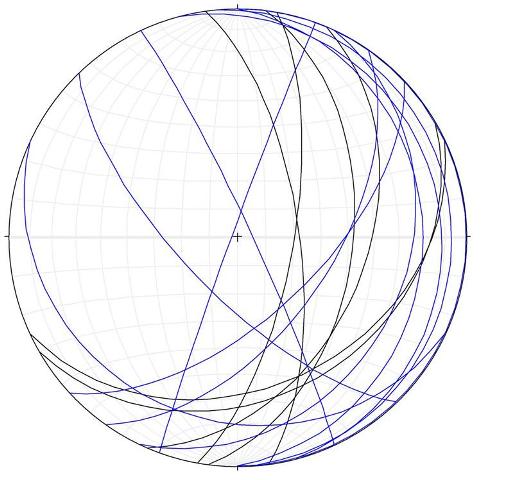
Level 3: The Catoctin Formation.
The Catoctin Formation is a unit of flood basalts which originated during the rifting of Rodinia. After millions of years as a supercontinent, heat began to build up under the interior of the continent. As the heat reached the bottom of the lithosphere it spread out beginning to pull the continent in multiple directions. As shown in failure envelopes the tensile strength of a rock is far weaker than the compressive strength of the same rock. This resulted in rifting. Where the rifts formed the were thin weak spots in the crust which allowed basalts to flow up to the surface and flood the area. The Catoctin was one such flood basalt. Many people associate basalt with a black color. Today, the Catoctin is actually a shade of green. This is the result of epidotization during the Appalachian Orogenies. Because of its green nature the Catoctin is commonly called the “Catoctin Greenstone”. The Catoctin Formation shows many primary structures from deposition as well as several features from alteration during the orogenies.
Perhaps the most fantastic feature of the Catoctin Formation is that in many places it is present as dikes. When Rodinia split, feeder dikes opened up throughout what is now the Blue Ridge in order to facilitate the outpouring of basalt. Many of these dykes are still visible in the underlying strata. Typically these dikes trend north-east to south-west. We found several along Skyline Drive in Shenandoah National Park. Below is a picture of one such dike.

We had the opportunity to measure its orientation and found that it had a south-east strike and a dip to the west. Below is a stereonet depicting the orientation of the dyke we measured in blue. The black planes are the orientations of several of the dykes one climbs through when hiking Old Rag Mountain which are also Catoctin feeder dikes.
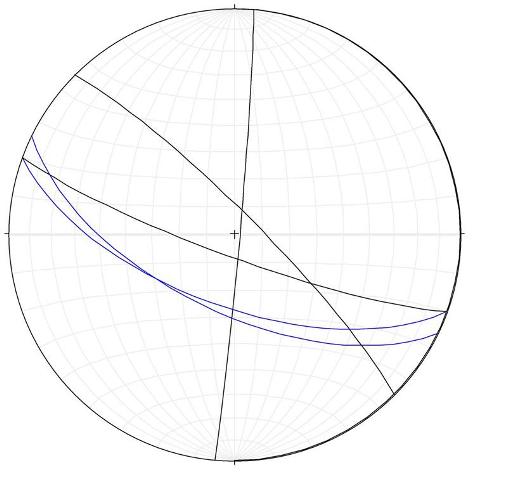
When the basalt reaches the surface it instantly begins to cool. AS with many things when cooling occurs relatively rapidly it leads to brittle deformation, in this case fracturing. In several places throughout the national park basaltic columns are visible. These form when the lava cools from top to bottom with the top cooling faster with slower cooling occurring deeper and deeper in the flow. As the rock cools it contracts and fractures form. These fractures tend to form as triple joints. The principle is similar to that of mud cracks or even triple rifts on the plate tectonics scale. The joints then expand meeting with other triple joints forming polygons on the cooling surface, the most common being hexagons. These sets of joints then propagate in the direction of cooling forming columns. The same thing occurs from the contact with the ground under the flow and works upward. Eventually the two meet in the middle. The picture at the top of this post shows some of the columns at Compton Peak in the background.
We had the opportunity to visit two sets of columns on our trip. One set was along the Limberlost trail and the other was on Compton Peak. We were tasked with evaluating these columns. One of our primary objectives was to measure the columns and find out what was different between them.
The Limberlost Columns:
These columns had obviously been sheared. The question became how much? And what did this do to the angle of the triple joints?
I first calculated the angular shear of the columns. I did this by measuring the angle between the top of the most acute angle I could find between the top of the column and a face. From my vantage point Y=+45. From this I used the equation angular shear g=tanY. The result was an angular shear of 1.

Photo courtesy of Maya A.
Another part of working in the field is learning as you go. I didn’t have a good way of measuring the interior angles of the sheared columns while we were on the Limberlost Trail. While we were there I used a protractor to measure the angles. Unfortunately, because of the between the side of the column and the top the measurements were likely distorted. Even so, the data does show some of the alteration in angles caused by the shear. We measured a 7 sided column. As with any 7 sided polygon the sum of the interior angles should be approximately 900 degrees. For this one it was 909.0 degrees. Starting in one triple joint and working around the edge the angles are as follows. 150, 110, 145, 145, 110, 116, and 135 degrees. On a standard septagon the interior angles are each 128 degrees. In this case, the interior angles of the polygon that are in line with the shear direction are decreased and those “perpendicular” to the shear direction are expanded. This is shown in the picture below.

Photo courtesy of Laura S.
COMPTON PEAK

After visiting the Limberlost Trail we did the Compton Peak Trail which lead to some of the most incredible columnar jointing on the east coast. Here we are viewing the columns from the bottom. These columns are not sheared as the ones at the Limberlost Trail were. This gives us a look at unaltered columns. For these columns there was no angular shear. However I did need to measure the interior angles. For this, I had asked a few questions, thought about my method a little, and came up with a better way of measuring the angles. I decided to measure the orientation of the column faces and then use stereonets to find the interlimb angles. This is shown below. The planes for column 2 are in red. The calculated interlimb angles were as follows, for column 1 one was 128.5 and the other was 146 degrees. For column 2 one angle was 120 and the other was 158 degrees.

One of the most common features of the catoctin formation is the large quantity of amygdules. Amygdules which are a secondary feature, were once vesicles a primary feature. When the basalts first reached the surface and spread out they began to degas. Bubbles of gas began to rise to the surface of the flows trying to escape. Some of the bubbles made and others didn’t. The ones that failed to escape were trapped, concentrated near the top of the flows, for all time. Then, later, fluids begain to percolate through the rocks, particularly during the Appalachian Orogeny. It was at this time the minerals began to crystallize in the cavities left by the gas bubbles forming amygdules. Most commonly one finds epidote amygdules. Sadly none of my amygdule pictures turned out well from this trip so I had to pull the picture below from another trip I took into the field. This picture was taken along I-64 east of the Skyline Drive Entrance.

Also in the Catoctin are areas of volcanic breccias which are the result of pyroclastic flows or lahars. Both of which are unconsolidated flows of volcanic material which result in an angular conglomeratic rock as shown below.

Level 3: The Chilhowee Group.
We had two opportunities to view formations from the Chilhowee Group during our field trip. The first came on day 1 when we finished early. We then proceeded to visit an outcrop of the Harpers Formation (The middle formation of the Chilhowee Group) in Beldore Valley.
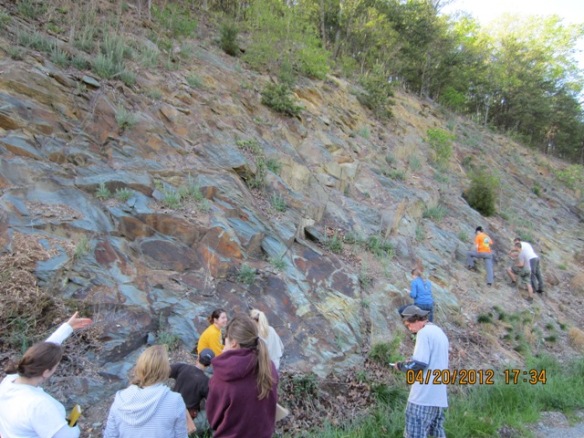
It is typically brown with particle sizes from mud sized particles and areas of sand size particles which were deposited after the rifting of Rodinia. The sediment was also metamorphosed during the Appalachian orogeny. Since we were on the western edge of the Blue Ridge I was excited to find evidence of the overturn. As such I began looking for bedding and cleavage relationships. When bedding and cleavage both dip in the same direction and the bedding dips more steeply it is likely that you are viewing an overturned bed. Sadly, this was not the case here. The data I collected is shown below (Bedding is in blue).

While I was unable to find the relationship I was looking for on the Structure Field Trip, I did find evidence of the overturn just this past weekend. It is shown below in all its overturned glory.

Another feature we saw in the Harpers Formation was Boudinage of feldspar veins. During the Appalachian Orogeny the region underwent compression where there were two primary forces d1 and d 2 were stronger than the d 3 thus the feldspars were smashed into a cigar shape also known as prolate. Eventually, the feldspars broke and the space between was filled in by the softer rock. This is shown below.
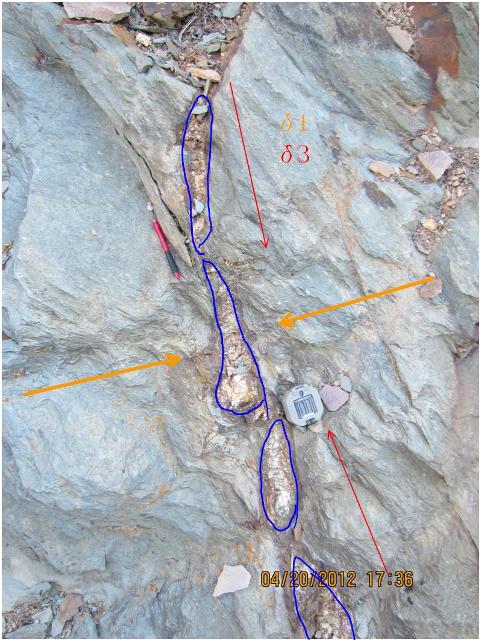
There were also fantastic plume structures which indicated the propagation direction of the fractures creating joints in the rocks which is shown below.
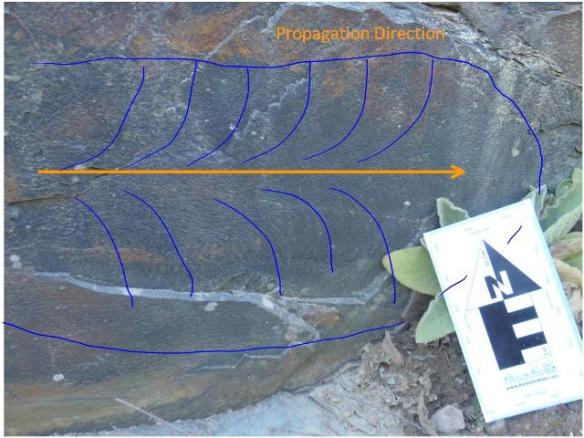
We also saw the Antietam Formation in the roadside walls of Skyline Drive. The Antietam is a relatively pure white sandstone which is known for its abundance of skolithos tubes which will be discussed below. While the slabs of rock were float, they still told an amazing story of the processes undergone by the sandstone.
The trademark features of the Antietam Formation are the skolithos tubes which are common in the formation. Skolithos are trace fossils of worm tubes. The sediment that makes up the formation was an ancient shallow marine environment in which worms lived. The worms used to burrow their way down into the sand. These tubes were then filled in by other sediment and then lithified preserving the tubes. Another interesting factoid is that the worms always burrowed straight down. This makes the skolithos tubes useful geopedal structures as shown below.

There are also tension gashes in some of the slabs. These form when the rock is being sheared. Fractures then form along weak zones and open up into gashes which are then filled by mineral bearing solutions (in this case bearing silica) which then crystallize. When several gashes form in a line they are known as en echelon tension gashes. A neat attribute of some of the tension gashes shown below is that they were further sheared after they formed giving them a distinctive S shape. Even more interesting are the skolithos tubes that are bisected by the tension gashes. These reinforce the sense of shear.
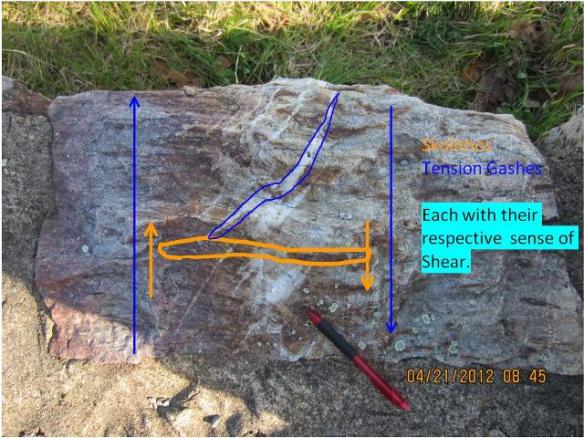
Part Two: The Massanutten Synclinorium
The Massanutten Sunclinorium shown below is located in the Valley and Ridge Province of Virginia. It was formed during the Alleghenian Orogeny. While at Massanutten we did some detailed analyses of the parasitic folds in Veach Gap. There were a series of 3 anticlines and 3 synclines located up in the gap. Before the rain hit I had time to get data from 3 of the six folds which I then called anticline 1, syncline 1, and anticline 2. For each I took readings for the limbs in order to use stereonets to find the axial hinges. All of the folds appeared to be disharmonic and concentric. The three folds were arranged as shown below.

Anticline 1:
Under the Fleuty system of classification this would be an upright gently plunging fold with a Hudleston Classification of 4E to C3.


The plunge and trend of the axial hinge is 37.2° à008.1°
Syncline 1:
The hinge of this fold was submerged beneath the soil so it was impossible to give it the proper classification and descriptions. The stereonet data for the syncline is shown below.

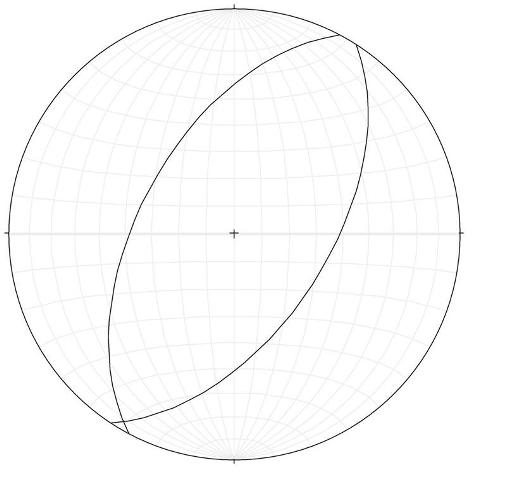
The plunge and trend of the axial hinge is 03.6° à210°
Anticline 2:
This was another upright, gently plunging fold with a Hudleston Classification of E3.

The plunge and trend of the axial hinge is 25.6° à214°
Sadly, this was the end of our trip. Beyond this point the weather was most uncooperative so we had to call it quits early and that was the end of our trip which started 1 billion years in the past and finished up 500 million years ago. Mind you we took a short cut making it in only 2 days while the rocks had to take the long route. Untill next time…






